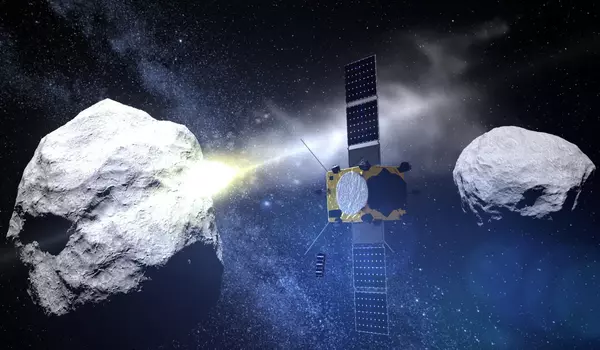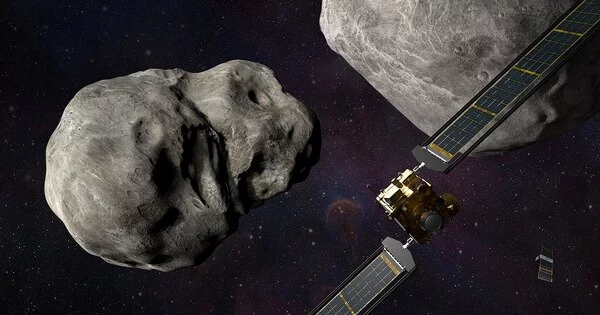The Double Asteroid Redirection Test (DART) mission is designed to test whether a spacecraft impact can deflect an asteroid’s trajectory, should a potentially hazardous asteroid be detected in the future. The target of the DART mission is the binary asteroid system Didymos, which consists of a primary asteroid and a smaller moonlet orbiting it.
When asteroids collide in space, debris flies away from the point of impact. The asteroid’s physical characteristics can be determined by the tail of particles that form. NASA’s Double Asteroid Redirection Test mission in September 2022 provided a unique opportunity for a team of scientists, including Rahil Makadia, a Ph.D. student in the Department of Aerospace Engineering at the University of Illinois Urbana-Champaign, to observe the evolution of an asteroid’s ejecta for the first time.
“My work on this mission thus far has been to study the heliocentric changes to the orbit of Didymos and its smaller moon Dimorphos – the DART spacecraft’s target,” Makadia explained. “Even though it hit the secondary, the entire system’s orbit around the sun changes as a result of the impact because the entire system feels the effects of the impact. In addition to the impact, the ejecta that escapes the system provides an additional boost. To accurately predict where the system will be in 100 years, you must first understand the contribution of the ejecta that escaped the system.”
We can determine how long ago that impact occurred based on the type of particles in the tail and their sizes. And we’ll be able to understand the ejecta that escape the system and change the heliocentric orbit of the entire system.
Rahil Makadia
The team observed a 33-minute change in the orbit after DART’s impact. Makadia said, if there were no ejecta, the period change would have been less than 33 minutes. But because some ejecta escaped the gravitational pull of Dimorphos, the orbit period change is higher than if there were no ejecta at all.
These three panels depict the asteroid Dimorphos breaking up after being deliberately hit by NASA’s 1,200-pound Double Asteroid Redirection Test mission spacecraft on September 26, 2022. The Hubble Space Telescope got a front-row seat to the space demolition derby. The top panel, taken 2 hours after impact, depicts an ejecta cone containing an estimated 1,000 tons of dust. The center frame depicts the dynamic interaction within the asteroid’s binary system, which begins to distort the cone shape of the ejecta pattern about 17 hours after the impact.
The most noticeable structures are rotating, pinwheel-shaped elements. Didymos, the companion asteroid, exerts gravitational pull on the pinwheel. Hubble then captures debris being swept back into a comet-like tail by the pressure of sunlight on the tiny dust particles in the bottom frame. This expands into a debris train, with the lightest particles traveling the fastest and furthest away from the asteroid. The mystery is heightened when Hubble observes the tail splitting in two for several days.

The study, published in the journal Nature, focused on the Hubble Space Telescope’s measurements of the ejecta, beginning 15 minutes after the impact to 18 ½ days after the impact. The images showed the exact evolution of the tail and how it evolved over time.
“After a few days,” Makadia explained, “the primary force acting on these ejecta particles becomes solar radiation pressure. The photons emitted by the sun accelerate these small particles, causing them to form a straight tail in an anti-solar direction. In some cases, it has been determined that the observed active asteroid was caused by a natural impact. However, because this one was clearly intended, we could point telescopes at it before and after the impact to study its evolution.”
He stated that the data on how this ejecta evolves will be used to understand how the entire system’s orbit changes.
“Now that we have this treasure trove of data,” Makadia explained, “we can make educated guesses about other tails we might observe.” “We can determine how long ago that impact occurred based on the type of particles in the tail and their sizes. And we’ll be able to understand the ejecta that escape the system and change the heliocentric orbit of the entire system.”
Makadia, who will graduate from UIUC in 2020, said that almost all of his work is computational.
“In order to calculate where an asteroid will be on a given date, we must propagate all of the possible locations that the asteroid could be at an initial time, rather than just one nominal solution. That requires a lot of computational power and understanding of how orbits are affected by small forces, like solar radiation pressure as well as gravity from all kinds of sources within the solar system.”
“When I first started working on my Ph.D., I created simulations to study heliocentric changes to ensure that we have a propagator that can impart all of these impulses from escaping ejecta. Now I’m working on an orbit determination tool so that once we have enough observations, we can extract this information about the system’s heliocentric change.”
Makadia stated about the project, “This is the most thrilling experience I’ve ever had. It’s completely real, but it’s also astonishing. Even now, when people ask about it, it sounds like I’m discussing a movie plot rather than an actual event.”





